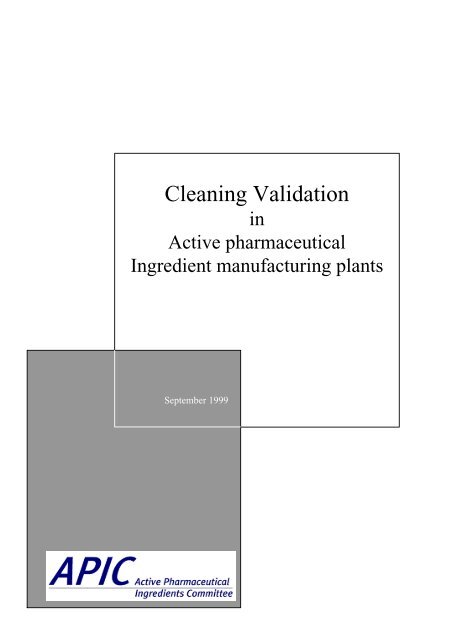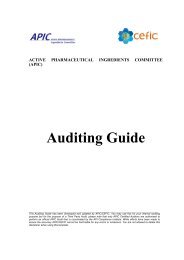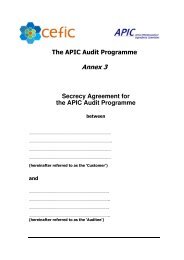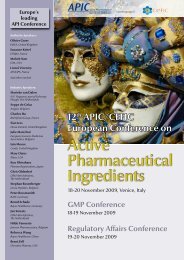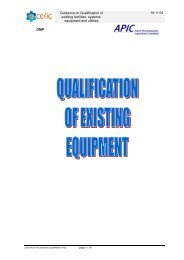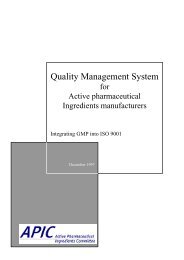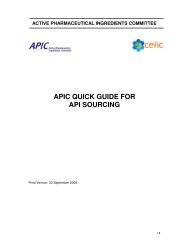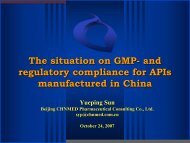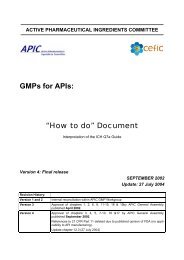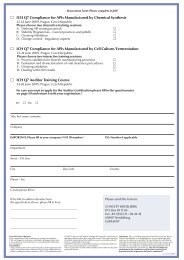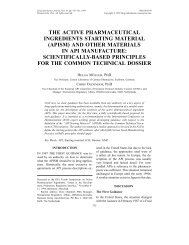Cleaning Validation in Active pharmaceutical Ingredient ...
Cleaning Validation in Active pharmaceutical Ingredient ...
Cleaning Validation in Active pharmaceutical Ingredient ...
- No tags were found...
Create successful ePaper yourself
Turn your PDF publications into a flip-book with our unique Google optimized e-Paper software.
<strong>Clean<strong>in</strong>g</strong> <strong>Validation</strong><strong>in</strong><strong>Active</strong> <strong>pharmaceutical</strong><strong>Ingredient</strong> manufactur<strong>in</strong>g plantsSeptember 1999
Guide to <strong>Clean<strong>in</strong>g</strong> <strong>Validation</strong> <strong>in</strong> API plantsTable of contents1. Foreword....................................................................................................…..... 22. Objective....................................................................................................…..... 33. Scope..……................................................................................................…..... 44. Potential residues …………………………….................................................. 55. Current regulatory guidance……………….................................................... 66. <strong>Clean<strong>in</strong>g</strong> validation policy........................................................................…..... 77. Levels of clean<strong>in</strong>g.………….....................................................................…..... 88. Elements of clean<strong>in</strong>g validation...............................................................…..... 108.1 Establishment of acceptance criteria….................................................... 128.1.1 chemical determ<strong>in</strong>ation ........................................................................ 128.1.2 physical determ<strong>in</strong>ation ......................................................................... 138.1.3 microbiological determ<strong>in</strong>ation.............................................................. 138.2 <strong>Clean<strong>in</strong>g</strong> procedures ............................................................................... 138.3 Sampl<strong>in</strong>g ................................................................................................ 158.4 Analytical methods…. ............................................................................ 168.5 <strong>Validation</strong> protocols ............................................................................... 178.6 <strong>Validation</strong> reports................................................................................... 189. M<strong>in</strong>imum requirements...........…..............................................................…..... 2010. Change control…………..........…..............................................................…..... 2111. Summary………………...........…..............................................................…..... 2212. References…………..…...........…..............................................................…..... 23
Guide to <strong>Clean<strong>in</strong>g</strong> <strong>Validation</strong> <strong>in</strong> API plants1. ForewordThis Guidel<strong>in</strong>e has been produced by the <strong>Active</strong> Pharmaceutical <strong>Ingredient</strong>s Committee(APIC) Work<strong>in</strong>g group.Different organizations will be <strong>in</strong>fluenced by their companies and the markets that theyserve <strong>in</strong> the approaches that they take and the policies that they have with respect tothe subject.It is also valuable to bear <strong>in</strong> m<strong>in</strong>d that this is an area that is chang<strong>in</strong>g rapidly and whatwas considered as be<strong>in</strong>g acceptable 2-5 years ago is now not adequate. Therefore,companies should be aware of the need to cont<strong>in</strong>uously update themselves on currentregulatory requirements.2
Guide to <strong>Clean<strong>in</strong>g</strong> <strong>Validation</strong> <strong>in</strong> API plants2. ObjectiveThe <strong>in</strong>tention of this document has been to def<strong>in</strong>e a comprehensive approach to the<strong>Validation</strong> of <strong>Clean<strong>in</strong>g</strong> procedures <strong>in</strong> <strong>Active</strong> Pharmaceutical <strong>Ingredient</strong> manufactur<strong>in</strong>gfacilities.<strong>Clean<strong>in</strong>g</strong> <strong>Validation</strong> <strong>in</strong> the context of <strong>Active</strong> Pharmaceutical <strong>Ingredient</strong> manufacturemay be def<strong>in</strong>ed as:The process of provid<strong>in</strong>g documented evidence that the clean<strong>in</strong>g methodsemployed with<strong>in</strong> a facility consistently controls potential carryover of product(<strong>in</strong>clud<strong>in</strong>g <strong>in</strong>termediates and impurities), clean<strong>in</strong>g agents and extraneousmaterial <strong>in</strong>to subsequent product to a level which is below predeterm<strong>in</strong>ed levels.It is necessary to Validate <strong>Clean<strong>in</strong>g</strong> procedures for the follow<strong>in</strong>g reasons:a. It is a customer requirement - it ensures the safety and purity of the product.b. It is a regulatory requirement <strong>in</strong> <strong>Active</strong> Pharmaceutical <strong>Ingredient</strong> productmanufacture.c. It also assures from an <strong>in</strong>ternal control and compliance po<strong>in</strong>t of view the qualityof the process.3
Guide to <strong>Clean<strong>in</strong>g</strong> <strong>Validation</strong> <strong>in</strong> API plants3. ScopeThis Document will serve to:1. Def<strong>in</strong>e the basic concepts and terms associated with <strong>Clean<strong>in</strong>g</strong> <strong>Validation</strong> <strong>in</strong> the<strong>Active</strong> Pharmaceutical <strong>Ingredient</strong> <strong>in</strong>dustry.2. Serve as a guide from which Masterplans, Protocols and Reports may becompiled.Note: General validation pr<strong>in</strong>ciples and a glossary of terms also relevant to clean<strong>in</strong>gvalidation are detailed <strong>in</strong> the CEFIC / EFPIA Guide entitled ‘Good Manufactur<strong>in</strong>gPractices for <strong>Active</strong> Pharmaceutical <strong>Ingredient</strong> Manufacturers’.It applies to sterile API’s only up to the po<strong>in</strong>t where the API is rendered sterile.4
Guide to <strong>Clean<strong>in</strong>g</strong> <strong>Validation</strong> <strong>in</strong> API plants4. Potential residuesThe <strong>Active</strong> Pharmaceutical <strong>Ingredient</strong> Industry <strong>in</strong>volves (<strong>in</strong> general) the manufacture of<strong>Active</strong> Pharmaceutical <strong>Ingredient</strong>s by both chemical and physical means through aseries of multiple step processes. Plants or <strong>in</strong>dividual pieces of equipment, <strong>in</strong>clud<strong>in</strong>gancillary equipment, may be used <strong>in</strong> multi-product manufacture or dedicated to<strong>in</strong>dividual products.The result of <strong>in</strong>adequate clean<strong>in</strong>g procedures is that any of a number of contam<strong>in</strong>antsmay be present <strong>in</strong> the next batch manufactured on the equipment such as:1. Precursors to the <strong>Active</strong> Pharmaceutical <strong>Ingredient</strong>2. By-products and/or degradation products of the <strong>Active</strong> Pharmaceutical<strong>Ingredient</strong>3. The previous product4. Solvents and other materials employed dur<strong>in</strong>g the manufactur<strong>in</strong>g process.5. Micro-organismsThis is particularly the case where microbial growth may be susta<strong>in</strong>ed by theproduct.6. <strong>Clean<strong>in</strong>g</strong> agents themselves and lubricants5
Guide to <strong>Clean<strong>in</strong>g</strong> <strong>Validation</strong> <strong>in</strong> API plants5. Current regulatory guidanceRefer to the reference section of this document for details of current RegulatoryGuidance.6
Guide to <strong>Clean<strong>in</strong>g</strong> <strong>Validation</strong> <strong>in</strong> API plants6. <strong>Clean<strong>in</strong>g</strong> validation policyThe ma<strong>in</strong> focus of this document will be to describe equipment and ancillary equipment/ process <strong>Clean<strong>in</strong>g</strong> <strong>Validation</strong> <strong>in</strong> an <strong>Active</strong> Pharmaceutical <strong>Ingredient</strong> manufactur<strong>in</strong>gplant. However, it is appropriate to start by giv<strong>in</strong>g a brief <strong>in</strong>troduction as to how theconcept of <strong>Clean<strong>in</strong>g</strong> <strong>Validation</strong> should be approached <strong>in</strong> a facility.It is advisable for <strong>Active</strong> Pharmaceutical <strong>Ingredient</strong> manufactur<strong>in</strong>g facilities to hold anofficial <strong>Clean<strong>in</strong>g</strong> <strong>Validation</strong> Policy. Specific department responsibilities should beoutl<strong>in</strong>ed <strong>in</strong> this and it should be approved by senior management. This policy shouldserve to provide a general guidel<strong>in</strong>e and direction for company personnel, regulatoryauthorities and customers as to how the company deals with areas associated with<strong>Clean<strong>in</strong>g</strong> <strong>Validation</strong>.The policy should <strong>in</strong>corporate the follow<strong>in</strong>g types of statements:• Def<strong>in</strong>ition of terms employed dur<strong>in</strong>g validation i.e. r<strong>in</strong>se vs. flush vs. wash etc.• A statement specify<strong>in</strong>g what company policy is on validation of clean<strong>in</strong>gprocedures related to equipment (<strong>in</strong>clud<strong>in</strong>g ancillary) and processes.• Company policy re dedication of equipment <strong>in</strong> certa<strong>in</strong> cases (if products aredeemed too dangerous and / or highly active to manufacture on multi-productequipment).• Analytical validation policy.• The policy should also state the rational for the methods by which acceptancecriteria is determ<strong>in</strong>ed.• Revalidation policy.7
Guide to <strong>Clean<strong>in</strong>g</strong> <strong>Validation</strong> <strong>in</strong> API plantsTable 1: levels of clean<strong>in</strong>g9
Guide to <strong>Clean<strong>in</strong>g</strong> <strong>Validation</strong> <strong>in</strong> API plants8. Elements of clean<strong>in</strong>g validationA brief outl<strong>in</strong>e of the various elements of a basic clean<strong>in</strong>g validation study is givenbelow (see also Figure 1 on page 11).This is followed by a more detailed view of the <strong>in</strong>dividual elements <strong>in</strong> this section.I. Establishment of acceptance criteriaII. <strong>Clean<strong>in</strong>g</strong> procedure• Identification of the equipment• characterization of the products (Previous: activity/toxicity,solubility, subsequent: dosage, lot size)• determ<strong>in</strong>ation and characterization of the clean<strong>in</strong>g agentsIII. Analytical method and its validationIV. Sampl<strong>in</strong>g Procedure and necessary validation of sameV. <strong>Validation</strong> protocolVI. <strong>Validation</strong> report10
Guide to <strong>Clean<strong>in</strong>g</strong> <strong>Validation</strong> <strong>in</strong> API plantsFigure 1: <strong>Clean<strong>in</strong>g</strong> <strong>Validation</strong> ProcessSTAGE 1:DETERMINE THE MOST APPROPRIATE CLEANINGPROCEDURE FOR THE EQUIPMENT -1. Generate acceptance criteria data for the contam<strong>in</strong>ant.2. The clean<strong>in</strong>g method will be determ<strong>in</strong>ed by the process,the equipment the clean<strong>in</strong>g agents and the clean<strong>in</strong>gtechniques available.3. All aspects of the clean<strong>in</strong>g procedure should be clearlydef<strong>in</strong>ed <strong>in</strong> SOPs be they manual / CIP or COPDEVELOP AND VALIDATE THESAMPLING AND CHOSENANALYTICAL METHODSFOR THE COMPOUND(S) BEINGCLEANED1. Swab2. R<strong>in</strong>se(determ<strong>in</strong>e % recovery, limit of detection,limit of quantitation, accuracy of method,reproducibility, stability over time ...etc.)EVALUATE EQUIPMENT SURFACESAND DETERMINE1. Worst case locations to sample (swabsampl<strong>in</strong>g)1. Volume and type of r<strong>in</strong>se solvent to beemployed (r<strong>in</strong>se sampl<strong>in</strong>g)1. Equipment surface area (necessary tocalculate carryover <strong>in</strong>to subsequentbatches)STAGE 2: STAGE 3 STAGE 4:DEVELOP A CLEANING VALIDATION PROTOCOLFOR THE PRODUCT AND THE EQUIPMENT BEINGCLEANEDThat should encompass for example:1. Introduction2. Scope3. Equipment4. <strong>Clean<strong>in</strong>g</strong> procedure5. Sampl<strong>in</strong>g procedures6. Analytical test<strong>in</strong>g procedure7. Acceptance/<strong>Clean<strong>in</strong>g</strong> limits.8. Acceptance criteria for the validation.INTERIM REPORT:GENERATE INTERIM CLEANINGVALIDATION REPORTS ON A CLEAN BYCLEAN BASIS DETAILING THEACCEPTABILITY OF THE CLEANINGPROCEDURE FOR THE EQUIPMENT ANDTHE PRODUCT.This is only required where there is a longperiod of time between manufacture of thevalidation runs (see stage 4 for report<strong>in</strong>grequirements).GENERATE A CLEANING VALIDATIONREPORT DETAILING THE ACCEPTABILITYOF THE CLEANING PROCEDURE FOR THEEQUIPMENT AND THE PRODUCTThe report should give a full detailed background and<strong>in</strong>troduction to the clean<strong>in</strong>g <strong>Validation</strong> study andshould evaluate all data generated with respect to theacceptance criteria employed for the study. The reportshould also <strong>in</strong>dicate the requirement if any forrevalidation (period of time /change control etc.)11
Guide to <strong>Clean<strong>in</strong>g</strong> <strong>Validation</strong> <strong>in</strong> API plants8.1 Establishment of acceptance criteriaThe <strong>Clean<strong>in</strong>g</strong> <strong>Validation</strong> should demonstrate that the procedure consistentlyremoves residues of the substance previously manufactured down to levels thatare acceptable and that the clean<strong>in</strong>g procedure itself does not contributeunacceptable levels of residual materials to the equipment. The limits setshould be practical, achievable and justifiable.In <strong>Active</strong> Pharmaceutical <strong>Ingredient</strong> manufacture there may be partial reactantsand unwanted by-products which may not have been chemically identified.Therefore, it may be necessary to focus on by-products as well as the pr<strong>in</strong>ciplereactant. Companies should decide on which residue(s) to quantify based onsound scientific rational.8.1.1 Chemical determ<strong>in</strong>ationIt is generally the residual <strong>Active</strong> Pharmaceutical <strong>Ingredient</strong> or <strong>in</strong>termediate,which is of greatest concern rather than reaction side products or residualimpurities.There are a number of options available when determ<strong>in</strong><strong>in</strong>g acceptance criteria.Where either toxicological or therapeutic data if available then calculation A orB is preferable. If data is not available for either of these calculations or if theresult is more str<strong>in</strong>gent calculation C should be used.A. Limit<strong>in</strong>g the level based on toxicity data.An Acceptable Daily Intake (ADI) is calculated with suitable safetyfactors applied and this is converted to the maximum allowablecarryover to the API.B. Pharmacological Dose Method:The philosophy is to reduce the levels of residual product <strong>in</strong> each pieceof equipment, such that no greater than 1/1000 of the normaltherapeutic dose will be present per typical dose of the next product tobe run <strong>in</strong> the equipment. The validation protocol should <strong>in</strong>clude acalculation, which ties this philosophy to the acceptance criteria for thesamples to be tested.C. Limit<strong>in</strong>g the level of product which could appear <strong>in</strong> the follow<strong>in</strong>gproducts.Limits from 10ppm up to 0.1% (based on the ICH impurity documentwhich <strong>in</strong>dicates that up to 0.1% of an <strong>in</strong>dividual unknown or 0.5% totalunknowns material may be present <strong>in</strong> the product be<strong>in</strong>g tested )Note FDA Statement on 0.1% impurities12
Guide to <strong>Clean<strong>in</strong>g</strong> <strong>Validation</strong> <strong>in</strong> API plantsFDA statement: P. Alcock, <strong>in</strong> Human Drug cGMP Notes, P. Motise,June 98: „...we have found that some firms have <strong>in</strong>correctly applied astheir acceptance limit the 0.1% impurity identification threshold asdiscussed <strong>in</strong> both the ICH impurity guidel<strong>in</strong>e and the U.S.P. GeneralNotices. This application of the 0.1% impurity threshold is<strong>in</strong>appropriate because the limit is <strong>in</strong>tended for qualify<strong>in</strong>g impurities thatare associated with the manufactur<strong>in</strong>g process of related compound andnot extraneous impurities caused by cross contam<strong>in</strong>ation. ...“ ) may beused depend<strong>in</strong>g on the stage of the process.It is also necessary to evaluate the ability of the clean<strong>in</strong>g procedure toremove any clean<strong>in</strong>g agents <strong>in</strong>troduced. The acceptance criteria for theresidual-clean<strong>in</strong>g agents should reflect the absence of these materials,with<strong>in</strong> the range of the capabilities of the assay and sampl<strong>in</strong>g methods.The <strong>in</strong>dividual company must decide on the Acceptance Criteria whichare justifiable for their particular situation.8.1.2 Physical determ<strong>in</strong>ationThere should be provision dur<strong>in</strong>g rout<strong>in</strong>e clean<strong>in</strong>g for a visual exam<strong>in</strong>ation ofthe equipment, verify<strong>in</strong>g that it is free of visible residues. The validationprotocol should <strong>in</strong>clude this requirement as an acceptance criteria. Dur<strong>in</strong>gvalidation, special attention should be given to areas that are ‘hard to clean’(e.g. agitator shafts, thermowells, discharge valves etc.) and areas that wouldbe difficult to verify on a rout<strong>in</strong>e basis.8.1.3 Microbiological determ<strong>in</strong>ationAppropriate studies should be performed (e.g. swabs and/or r<strong>in</strong>se sampl<strong>in</strong>g)where the possibility of microbial contam<strong>in</strong>ation of subsequent product isdeemed possible and presents a product quality risk.8.2 <strong>Clean<strong>in</strong>g</strong> proceduresWritten clean<strong>in</strong>g procedures for each piece of equipment and process 1 must beprepared. It is vital that the equipment design is evaluated <strong>in</strong> detail <strong>in</strong>conjunction with the product residues to be removed, the available clean<strong>in</strong>gagents and clean<strong>in</strong>g techniques when determ<strong>in</strong><strong>in</strong>g the optimum clean<strong>in</strong>gprocedure for the equipment.1 If one clean<strong>in</strong>g procedure has been shown to be adequate for a number of products, then it is onlynecessary to have one clean<strong>in</strong>g SOP for those products for each piece of equipment.13
Guide to <strong>Clean<strong>in</strong>g</strong> <strong>Validation</strong> <strong>in</strong> API plants<strong>Clean<strong>in</strong>g</strong> procedures should be sufficiently detailed to remove the possibility ofany <strong>in</strong>consistencies dur<strong>in</strong>g the clean<strong>in</strong>g process.A. Equipment parameters to be evaluated• Identification of the equipment to be cleaned• Difficult to clean areas• Property of materials• Ease of disassembly• Fixed or not• Etc.B. Residues to be cleaned• <strong>Clean<strong>in</strong>g</strong> limits• Solubility's of the residues• Length of campaigns• Etc.C. <strong>Clean<strong>in</strong>g</strong> agent parameters to be evaluated• Preferably materials that are normally used <strong>in</strong> the process• Detergents available (as a general guide, m<strong>in</strong>imize use of detergents unlessabsolutely required)• Solubility properties• Environmental considerations.• Health and safety considerations• Etc.D. <strong>Clean<strong>in</strong>g</strong> techniques to be evaluated• Manual clean<strong>in</strong>g• CIP (Clean-<strong>in</strong> place)• COP (clean-out-of-place)• Semi automatic• Automatic• Time considerations• Number of clean<strong>in</strong>g cycles• Etc.E. Other requirements14
Guide to <strong>Clean<strong>in</strong>g</strong> <strong>Validation</strong> <strong>in</strong> API plantsProcedures must be determ<strong>in</strong>ed to be operator <strong>in</strong>dependent i.e. rugged andreproducible, dur<strong>in</strong>g the validation studies.The <strong>Clean<strong>in</strong>g</strong> documentation should <strong>in</strong>clude the follow<strong>in</strong>g items <strong>in</strong> order to ensure thatit can be followed reproducibly and ma<strong>in</strong>ta<strong>in</strong>ed subsequent to <strong>Validation</strong>.• Detailed def<strong>in</strong>ition of levels of clean<strong>in</strong>g to be performed.• Detailed description of clean<strong>in</strong>g methods.• The necessity to <strong>in</strong>spect and verify equipment cleanl<strong>in</strong>ess prior to manufacture ofnext batch should be stated <strong>in</strong> the SOP and recorded on the batch record.• The SOP should detail where verification of cycle parameters (if automated) andchecklists (for complex manual procedures) is necessary.• Where microbial contam<strong>in</strong>ation may be an issue, consideration should be given tothe <strong>in</strong>tegrity of the vessel prior to manufacture.Written clean<strong>in</strong>g procedures may also <strong>in</strong>clude additional items not specified above,these would <strong>in</strong>clude, as an example, the steps needed to protect the equipment fromcontam<strong>in</strong>ation after clean<strong>in</strong>g.8.3 Sampl<strong>in</strong>gIn develop<strong>in</strong>g the sampl<strong>in</strong>g plan for a validation study, it makes scientific senseto<strong>in</strong>corporate an understand<strong>in</strong>g of the acceptance criteria and the limitations of thesampl<strong>in</strong>g method relative to the surface to be sampled.The two methods of sampl<strong>in</strong>g generally employed are swab and / or r<strong>in</strong>sesampl<strong>in</strong>g. (If neither or these methods is shown be a scientifically sound methodfor test<strong>in</strong>g <strong>in</strong> a specific <strong>in</strong>stance then an alternative is to consider test<strong>in</strong>g the nextproduct.)The selection of either of these techniques must be consistent with soundscientific judgment and must support the objective of the study, which is todemonstrate that the amount of residual material <strong>in</strong> the equipment has beenreduced to acceptable levels.Each method is described <strong>in</strong> brief below.1. SWAB:• Swab sampl<strong>in</strong>g does not cover the entire equipment surface area thereforesites must be chosen with care. It is important that, as a m<strong>in</strong>imum, the15
Guide to <strong>Clean<strong>in</strong>g</strong> <strong>Validation</strong> <strong>in</strong> API plantsswab sites represent worst case locations on the equipment and that theresult is then extrapolated to account for the total product contact surfacearea. This calculation makes it possible to make a worst case determ<strong>in</strong>ationof potential carryover <strong>in</strong>to subsequent product.• Due to the nature of this method which employs physical forces as well aschemical forces it may be necessary to perform sampl<strong>in</strong>g techniqueevaluation.• Swabb<strong>in</strong>g efficiency (% recovery) for the swabb<strong>in</strong>g method must bedeterm<strong>in</strong>ed.• It is necessary to ensure that extractables of the swab do not <strong>in</strong>terfere withthe sampl<strong>in</strong>g method.• Us<strong>in</strong>g this technique it is possible to sample <strong>in</strong>soluble residues due to thephysical action associated it.2. RINSE:• The solvent r<strong>in</strong>se occurs after clean<strong>in</strong>g has been completed• This method is not as direct as swabb<strong>in</strong>g but will cover the entire surfacearea (and parts <strong>in</strong>accessible to swabs)• It is important to ensure chosen solvent has appropriate recovery forresidues be<strong>in</strong>g quantified• This method allows much greater ease of sampl<strong>in</strong>g than swabb<strong>in</strong>g• A reduced no of samples are required to generate a carryover figure.(Other sampl<strong>in</strong>g methods which may be employed <strong>in</strong> addition to swab / r<strong>in</strong>sesampl<strong>in</strong>g dur<strong>in</strong>g a validation may <strong>in</strong>clude: placebo sampl<strong>in</strong>g, test<strong>in</strong>g subsequentbatches for residues, use of coupons (test pieces), etc. )8.4 Analytical methodsIn order for the analytical test<strong>in</strong>g of the clean<strong>in</strong>g validation samples (swabs orr<strong>in</strong>ses) to yield mean<strong>in</strong>gful results, the analytical methods used should bevalidated. This should be documented.The basic requirements are:• The ability to detect the target substance(s) at levels consistent with theacceptance criteria• The ability to detect the target substance(s) <strong>in</strong> the presence of othermaterials that may also be present <strong>in</strong> the sample (selectivity)(Companies might want to consider the follow<strong>in</strong>g:16
Guide to <strong>Clean<strong>in</strong>g</strong> <strong>Validation</strong> <strong>in</strong> API plantsWhere more than one impurity is suspected (which is probably the normalcase <strong>in</strong> API manufactur<strong>in</strong>g) a method could be proposed that is notnecessarily specific for each of the impurities but detects them alltogether. Then additionally the assumption must be made, that the worstcase (e.g. most active) impurity represents the whole residue. This issecure approach for the patients and could be accepted by the authorities.It is also an practicable approach for the <strong>in</strong>dustry because such methodsare for example dry residue determ<strong>in</strong>ation for non volatile impurities orTOC determ<strong>in</strong>ation for water r<strong>in</strong>ses, which are very simple methods. )• The analytical method should <strong>in</strong>clude a calculation to convert the amountof residue detected <strong>in</strong> the sample to 100% if the recovery data generated<strong>in</strong>dicates a recovery outside of an allowed range.• Stability of samples over time if the time <strong>in</strong>terval between removal andtest<strong>in</strong>g of samples potentially effects sample <strong>in</strong>tegrity.8.5 <strong>Validation</strong> protocolsA <strong>Validation</strong> Protocol is necessary to def<strong>in</strong>e the specific items and activitiesthat will constitute a clean<strong>in</strong>g validation study. It is advisable for companies tohave drawn up a Master <strong>Validation</strong> plan <strong>in</strong>dicat<strong>in</strong>g the overall <strong>Clean<strong>in</strong>g</strong><strong>Validation</strong> strategy for either the product range / equipment type / entire site.The protocol must be prepared prior to the <strong>in</strong>itiation of the study and musteither <strong>in</strong>clude or reference the documentation required to provide the follow<strong>in</strong>g<strong>in</strong>formation:• The objective of the study:What clean<strong>in</strong>g process is to be validated (<strong>in</strong>dicat<strong>in</strong>g the product to beremoved and the equipment from which it is to be removed)?If this study is to be employed to demonstrate the acceptability of theclean<strong>in</strong>g procedure for a group of products the rational for do<strong>in</strong>g soshould also be detailed here.The clean<strong>in</strong>g procedure(s) to be validated should be identified i.e.clean<strong>in</strong>g agents, soakage times, equipment parameters, number ofclean<strong>in</strong>g cycles etc.17
Guide to <strong>Clean<strong>in</strong>g</strong> <strong>Validation</strong> <strong>in</strong> API plants• Scope of the study:The company must evaluate the process and determ<strong>in</strong>e which residues areto be tested for and which are not to be based on sound scientificrational.What residues (<strong>in</strong>clud<strong>in</strong>g clean<strong>in</strong>g agents) are to be tested for, why thoseresidues (if more residues may be present than are be<strong>in</strong>g tested for allresidues should be under control see comments at 8.4). How many timesshould the study be run before a report is compiled and recommendationsmade.• List<strong>in</strong>g of the process parameters to be verifiedThis is particularly necessary when automated or semi-automatedclean<strong>in</strong>g techniques are to be employed.• Sampl<strong>in</strong>g and <strong>in</strong>spection procedure to be used.The types of sampl<strong>in</strong>g methods to be used, where the samples are to beremoved from and how many samples are to be taken. Any particularrequirements should also be stated i.e. for sterile sampl<strong>in</strong>g / sampl<strong>in</strong>glight sensitive products.An equipment sampl<strong>in</strong>g diagram should be referenced.• Personnel responsibilities dur<strong>in</strong>g the study• Test methods to be used (should be referenced): See Section 8.4.• Acceptance criteriaPhysical: see section 8.1.2Chemical: see section 8.1.1(The rational for this criterion should be given along with a calculationstep.)• Change control: See section 10.• Approval of protocol before the study.18
Guide to <strong>Clean<strong>in</strong>g</strong> <strong>Validation</strong> <strong>in</strong> API plants8.6 <strong>Validation</strong> reportsA validation report is necessary to present the results and conclusions andsecure approval of the study. The report should <strong>in</strong>clude the follow<strong>in</strong>g:• Summary of or reference to the procedures used to clean, sample and test• Physical and analytical test results or references for same, as well as anypert<strong>in</strong>ent observations• Conclusions regard<strong>in</strong>g the acceptability of the results, and the status ofthe procedure(s) be<strong>in</strong>g validated• Any recommendations based on the results or relevant <strong>in</strong>formationobta<strong>in</strong>ed dur<strong>in</strong>g the study <strong>in</strong>clud<strong>in</strong>g revalidation practices if applicable.• Approval of conclusions• Review any deviations for the protocol that occurred.• In cases where it is unlikely that further batches of the product will bemanufactured for a period of time it is advisable to generate <strong>in</strong>terimreports on a batch by batch basis until such time as the clean<strong>in</strong>g validationstudy has been completed. (Typically, <strong>in</strong> <strong>Active</strong> Pharmaceutical<strong>Ingredient</strong> Pharmaceutical manufacture, verification is deemedappropriate dur<strong>in</strong>g development of the clean<strong>in</strong>g methods. Whereproducts are manufactured <strong>in</strong>frequently, verification may be applied overa period of time until all measur<strong>in</strong>g data has been collected for the<strong>Validation</strong> Report.)• The report should conclude an appropriate level of verificationsubsequent to validation.19
Guide to <strong>Clean<strong>in</strong>g</strong> <strong>Validation</strong> <strong>in</strong> API plants9. M<strong>in</strong>imum requirementsIf company policy is not to validate all equipment clean<strong>in</strong>g procedures for all productsthen as a m<strong>in</strong>imum requirement the validation policy should encompass conditionswhich represent the most appropriate challenges (worst case) to the procedure.These would <strong>in</strong>clude, as an example, such th<strong>in</strong>gs as:• Removal of products which conta<strong>in</strong> the products with the greatest biologicalactivity.• Removal of products conta<strong>in</strong><strong>in</strong>g the products/<strong>in</strong>termediates/byproducts with theleast solubility.These represent studies that are m<strong>in</strong>imally required as part of a validation, the resultsfrom which could be used to support lesser challenges to the procedure. It is oftentermed product group<strong>in</strong>g.• The maximum idle time before clean<strong>in</strong>g.A validation program generally encompasses three consecutive successful replicates toestablish that the procedure is reproducibly effective although companies shouldevaluate each situation <strong>in</strong>dividually.Where equipment of similar size, design and construction is cleaned by the sameprocedure, studies need not be conducted on each unit, as long as a total of threesuccessful replicates are done on similar pieces of equipment (equipment group<strong>in</strong>g).Concurrent <strong>Validation</strong> may be appropriate when product is manufactured <strong>in</strong>frequently.20
Guide to <strong>Clean<strong>in</strong>g</strong> <strong>Validation</strong> <strong>in</strong> API plants10. Change controlValidated clean<strong>in</strong>g procedures should be <strong>in</strong>cluded <strong>in</strong> the change control program. Thiswill ensure that any proposed changes are evaluated fully for their impact on thevalidated state of the procedure. Where deemed necessary, the proposed revisedprocedure may need to be validated prior to rout<strong>in</strong>e implementation.Cf. Change control chapter <strong>in</strong> the CEFIC / EFPIA Guide entitled ‘GoodManufactur<strong>in</strong>g Practices for <strong>Active</strong> <strong>Ingredient</strong> Manufacturers’In the absence of an <strong>in</strong>tentional change to a procedure, it is reasonable to assume thatproperly tra<strong>in</strong>ed operators or a properly qualified automated system will be able toexecute the procedure reproducibly and obta<strong>in</strong> the desired outcome - reduction ofresidue to acceptable levels. There may exist special circumstances that would suggestthat this assumption be verified via test<strong>in</strong>g. This may be addressed by periodic reviewsor re-evaluations.21
Guide to <strong>Clean<strong>in</strong>g</strong> <strong>Validation</strong> <strong>in</strong> API plants11. SummaryA validation policy should be written for a plant <strong>in</strong>clud<strong>in</strong>g clean<strong>in</strong>g validation.An clean<strong>in</strong>g validation program should conta<strong>in</strong> the follow<strong>in</strong>g elements:1. Assess equipment and products (previous, follow<strong>in</strong>g)2. Assess impact of this process on rout<strong>in</strong>e processes. If covered under bracket<strong>in</strong>gthen no further validation is required.3. Determ<strong>in</strong>e an appropriate clean<strong>in</strong>g agent and method4. Determ<strong>in</strong>e acceptance criteria for the residue(s) (<strong>in</strong>clud<strong>in</strong>g clean<strong>in</strong>g agents).5. Determ<strong>in</strong>e degree of evaluation required to validate the procedure.6. Decide what residue(s) (<strong>in</strong>clud<strong>in</strong>g clean<strong>in</strong>g agents), are to be tested for based onsolubilities, toxicities etc. and document rational beh<strong>in</strong>d decision.7. Develop sampl<strong>in</strong>g and analytical methods for recovery and detection of residues(swab/r<strong>in</strong>se, HPLC/dry residue etc.)8. Acceptance Criteria for the <strong>Validation</strong>9. Compile and approve <strong>Validation</strong> protocol10. Perform <strong>Validation</strong> Studies <strong>in</strong> accordance with protocol11. Compile and approve a <strong>Validation</strong> report document<strong>in</strong>g studies, conclusions andrecommendations.12. Revalidation policy22
Guide to <strong>Clean<strong>in</strong>g</strong> <strong>Validation</strong> <strong>in</strong> API plants12. ReferencesICH:• ICH Good Manufactur<strong>in</strong>g Practice Guidel<strong>in</strong>e for <strong>Active</strong> Pharmaceutical<strong>Ingredient</strong>s. (July 23 1999)PIC :• Pr<strong>in</strong>ciples of Qualification and <strong>Validation</strong> <strong>in</strong> Pharmaceutical Manufacture -Recommendations on <strong>Clean<strong>in</strong>g</strong> <strong>Validation</strong>. (ref. Document PR 1/ 99 March1999)FDA:• Guide to <strong>in</strong>spections of validation of clean<strong>in</strong>g processes (July 1993)• Biotechnology <strong>in</strong>spection guide (1991)• Foreign <strong>in</strong>spection guide (1992)• Guide to <strong>in</strong>spection of bulk <strong>pharmaceutical</strong> chemicals• Guide to <strong>in</strong>spections of topical drug products• Manufacture, process<strong>in</strong>g or hold<strong>in</strong>g of active <strong>pharmaceutical</strong> <strong>in</strong>gredients, draftdocument, FDA, March 1998.CEFIC / EFPIA:• Good Manufactur<strong>in</strong>g Practices for <strong>Active</strong> <strong>Ingredient</strong> Manufacturers - August1996.PHRMA :• Draft PhRMA BPC <strong>Clean<strong>in</strong>g</strong> <strong>Validation</strong> Guidel<strong>in</strong>e. (November 1996 Edition)OTHER PUBLICATIONS• S.W. Harder, ‘The validation of clean<strong>in</strong>g processes’, <strong>pharmaceutical</strong> technology.(1984)• James Agalloco, ‘Po<strong>in</strong>ts to consider <strong>in</strong> the validation of equipment clean<strong>in</strong>gprocedures’, Journal of parenteral science and technology. (October 1992)23
Guide to <strong>Clean<strong>in</strong>g</strong> <strong>Validation</strong> <strong>in</strong> API plants• Fourman Mullen, ‘Determ<strong>in</strong><strong>in</strong>g clean<strong>in</strong>g validation acceptance limits for<strong>pharmaceutical</strong> manufactur<strong>in</strong>g operations’, <strong>pharmaceutical</strong> technology. (April1993)• Mc Cormick, Cullen, ‘<strong>Clean<strong>in</strong>g</strong> validation’, <strong>pharmaceutical</strong> process validation,second edition. (1992)• Mc Arthur, Vasilevsky, ‘<strong>Clean<strong>in</strong>g</strong> validation for biological products: case study’,<strong>pharmaceutical</strong> eng<strong>in</strong>eer<strong>in</strong>g. (November / December 1995)• Zeller, ’<strong>Clean<strong>in</strong>g</strong> <strong>Validation</strong> and residue limits: a contribution to currentdiscussions’, <strong>pharmaceutical</strong> technology Europe. (November 1993)24
Guide to <strong>Clean<strong>in</strong>g</strong> <strong>Validation</strong> <strong>in</strong> API plantsCopyright and DisclaimerAll documents and <strong>in</strong>formation conta<strong>in</strong>ed <strong>in</strong> this guidance document are the propertyof the <strong>Active</strong> Pharmaceutical <strong>Ingredient</strong>s Committee. Users of this document may use<strong>in</strong>formation conta<strong>in</strong>ed there<strong>in</strong> only for personal use. No other use, <strong>in</strong>clud<strong>in</strong>greproduction, retransmission or edit<strong>in</strong>g, may be made without the prior writtenpermission of the <strong>Active</strong> Pharmaceutical <strong>Ingredient</strong>s Committee*.We have tried to make the <strong>in</strong>formation on or l<strong>in</strong>ked to this paper as accurate anduseful as possible. However, we can take no responsibility for mis<strong>in</strong>terpretationsof the <strong>in</strong>formation conta<strong>in</strong>ed <strong>in</strong> it.* Please contact the secretary of APIC at CEFIC25


